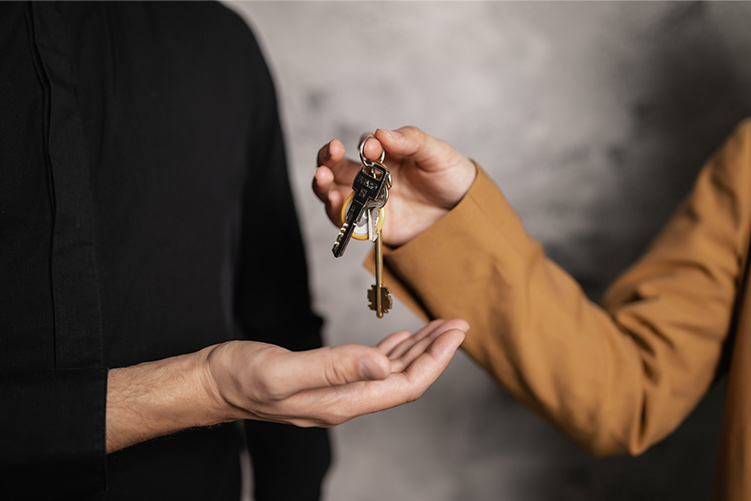Leasehold Explained
While there are many forms of title in the UK, most properties in the UK are either leasehold or freehold. Leasehold regulations and rules can be complex, and leasehold properties have often received bad press.
However, new government reforms and legislation are making it fairer for leaseholders. This ultimate guide provides an overview of leasehold and freehold properties and what you need to consider if you are buying either.
What is leasehold?
Leasehold is a type of property ownership where a person owns the right to use and occupy a property for a set period of time, but not the land on which the property is built. The property is owned by the freeholder who owns the land. The leaseholder has a contract or lease with the freeholder which sets out the rights and obligations of both parties.
This includes the length of the lease, service charges, and ground rent. Leasehold properties are commonly found in flats and apartments, but they can also apply to houses. The lease can be sold to another person, but the ownership of the land remains with the freeholder.
A guide to mortgages for flats
What is the difference between leasehold and freehold?
The main difference between leasehold and freehold is that leasehold is a form of property ownership where a person owns the right to occupy and use a property for a fixed period of time, but not the land on which it is built.
Whereas, freehold is a form of property ownership where a person owns both the property and the land on which it is built. In freehold ownership, the owner has complete control over the property and the land, subject to any legal restrictions. In contrast, leasehold ownership is subject to the terms of the lease agreement and the rights of the freeholder.
Northern Ireland & Scotland
In Northern Ireland, the rules on leasehold and freehold are similar to those in England and Wales. Leasehold properties are common, particularly in urban areas, and the leasehold rules are similar to those in
England and Wales. Freehold properties are also available, and there are no major differences in the rules around buying and owning freehold property.
In Scotland, most residential property is sold as freehold, with a few exceptions. The rules on common-hold and leasehold ownership are different from those in England and Wales, and leasehold ownership is much less common.
Speak To an Expert
Whether you’ve just had an offer accepted on a property and you’re ready to go, or you’re simply wondering how much you need to save for a deposit, it’s never too soon to reach out.
Leaseholds with less than 80 years worth avoiding
Leasehold properties with a remaining lease term of less than 80 years can become more expensive to extend or renew because of something called marriage value.
It’s worth trying to avoid buying a leasehold property with a short remaining lease term, but if you do, negotiate the price to reflect the shorter lease. Even if the remaining lease term is over 80 years, keep in mind that future buyers will be concerned about the length of the lease, so it may still affect the property’s value.
The cost of extending a lease
The cost of extending a lease can depend on several factors, including:
- Length of remaining lease term: Generally, the shorter the remaining lease term, the higher the cost of extending the lease. This is because the freeholder can demand more compensation for the loss of their investment.
- Value of the property: The value of the property can also play a role in the cost of extending the lease. If the property is very valuable, the freeholder may demand more money to extend the lease.
- Freeholder’s terms: The freeholder’s terms for extending the lease can also affect the cost. The freeholder may require a higher premium or ground rent, or impose other conditions that could increase the cost of the extension.
- Share of freehold: If the property is held on a share of freehold basis, the cost of extending the lease may be reduced as the leaseholder will have a share in the freehold.
- Legal and valuation fees: There may also be additional fees associated with extending the lease, such as legal and valuation fees.
It’s important to seek professional advice before extending a lease, as the cost and process can be complex and vary depending on the specific circumstances of the property.
The impact of marriage value – Extending a lease less than 80 years
80 years is a Milestone to avoid when it comes to leasehold properties when ‘Marriage value’ takes effect. The chart below shows the average impact of extending a lease at several lease terms.
| LEASE LENGTH | EXTENSION COST | PROFESSIONAL FEES (1) | TOTAL | POTENTIAL ADDED VALUE |
| 90 years | £4,500 | £4,000 | £8,500 | £12,500 |
| 85 years | £5,500 | £4,000 | £9,500 | £16,500 |
| 79 years | £13,000 | £4,000 | £17,000 | £19,500 |
| 70 years | £19,500 | £4,000 | £23,500 | £25,000 |
| 60 years | £28,000 | £4,000 | £32,000 | £33,00 |
Disadvantages of Leasehold flats
Whilst there are lots of well run leasehold flats that can be great homes or investments
There are several disadvantages to leasehold flats, including:
- Service charge: Leaseholders are required to pay an annual service charge to cover the cost of maintaining and repairing the building, as well as any shared spaces such as gardens, hallways, and lifts. The service charge can vary widely depending on the size and condition of the building, and can sometimes be expensive.
- Ground rent: Leaseholders are also required to pay an annual ground rent to the freeholder. This can be a fixed amount or a percentage of the property value, and can increase over time.
- Uncertain costs of extending the lease: As mentioned earlier, the cost of extending a lease can be expensive and uncertain, particularly if the lease has less than 80 years remaining. The freeholder may also impose additional fees and costs during the lease extension process.
- Restrictions on alterations: Leaseholders may be restricted in making alterations to their property without the freeholder’s permission, which can limit their ability to make changes to their home.
- Lack of control: Leaseholders have less control over the management of the building and its maintenance than freehold owners, and may not have a say in decisions that affect the property.
- Risk of forfeiture: If a leaseholder fails to pay service charge or ground rent, or breaches other terms of the lease, the freeholder may take legal action to forfeit the lease and take possession of the property. This can be a significant risk for leaseholders.
Advantages or owning a leasehold flat
Owning a leasehold flat can also have several benefits, including:
- Affordable entry: Leasehold flats can often be more affordable to purchase than freehold properties, making them an attractive option for first-time buyers or those looking to downsize.
- Low maintenance: As a leaseholder, you’re not responsible for the maintenance of the building’s exterior or common areas. This means you don’t have to worry about the cost or hassle of maintaining the roof, windows, or communal gardens.
- Amenities: Leasehold flats often come with access to amenities that you might not be able to afford with a freehold property, such as a gym, pool, or concierge service.
- Community: Living in a leasehold flat often means being part of a community. You’ll have neighbours who share the building and common areas, making it easy to make friends and socialise.
- Security: Many leasehold flats are located in secure buildings with gated entrances and CCTV, providing an extra level of security and peace of mind for residents.
Speak To an Expert
Whether you’ve just had an offer accepted on a property and you’re ready to go, or you’re simply wondering how much you need to save for a deposit, it’s never too soon to reach out.
Positive in legislation for leaseholders
leaseholders in England and Wales now have new rights and protections under recent government reforms. Some of the key changes include:
- Ground rent abolished: Ground rent will be abolished for new leasehold properties, meaning that new leases will be granted at zero ground rent.
- Reduced cost of Leasehold extensions: The cost of extending a lease will be reduced, with the introduction of a cap on the cost of extending a lease to 990 years for flats and 999 years for houses. Additionally, leaseholders will have the right to extend their lease by up to 990 years at zero ground rent.
- Right to manage: The process for leaseholders to take control of the management of their building (Right to Manage) will be made easier and more accessible.
- Easier access to information: Freeholders will be required to provide more information to leaseholders, including on how to buy their freehold or extend their lease.
These changes are designed to make leasehold properties fairer and more transparent for leaseholders.
How to complain as a Leaseholder
If you are facing issues with your leasehold property or have a complaint, there are several steps you can take to resolve the issue:
- Contact the Freeholder or Management Company: The first step is to contact the freeholder or management company responsible for the maintenance of the property. They may be able to resolve the issue directly or provide you with more information about the problem.
- Follow the Complaints Procedure: Most management companies have a complaints procedure in place, so follow this process to register your complaint formally. You may be asked to provide evidence to support your claim.
- Seek Legal Advice: If the issue is not resolved through the complaints procedure, you may need to seek legal advice. An experienced solicitor can help you understand your rights and advise you on the best course of action.
- Contact a Leasehold Advisory Service: The Leasehold Advisory Service (LEASE) provides free advice to leaseholders on leasehold law and disputes. They can help you understand your rights and provide guidance on resolving the issue.
- Consider Alternative Dispute Resolution: Alternative dispute resolution (ADR) is a way to resolve disputes without going to court. Options include mediation, arbitration, and adjudication.
What’s the difference between leasehold and share of freehold?
Leasehold and share of freehold are both forms of property ownership in the UK, but they differ in the extent of the ownership rights that the owner holds.
- Leasehold: Leasehold means that the owner has a lease on the property from the freeholder, which is usually a landlord or a property management company. The leaseholder has the right to occupy the property for a specified period of time, usually several decades, but does not own the land on which the property is built. The leaseholder pays ground rent to the freeholder and may be required to pay service charges for maintenance and repairs of common areas of the building.
- Share of freehold: Share of freehold means that the owner owns a share in the freehold of the building, along with the other owners of the other flats in the building. This means that the owners collectively own the building and the land on which it is built. They are responsible for maintaining the building and common areas and may have more control over decisions regarding the building’s management and maintenance. Share of freehold can be beneficial as it gives the owners greater control over their property and potentially lower costs in the long run, but it also comes with additional responsibilities and obligations.
What’s the process of extending a lease?
The process of extending a lease can vary depending on whether you are the leaseholder or the freeholder. Here is an overview of the general process:
For Leaseholders:
For Leaseholders
- Check the remaining lease term: The first step is to check how long is left on your lease. It is recommended to start the process of extending a lease when there are more than 80 years left on the lease to avoid additional costs.
- Get a valuation: You will need to get a valuation from a surveyor to determine the cost of extending the lease.
- Serve a Section 42 Notice: Once you have the valuation, you will need to serve a formal notice on the freeholder, known as a Section 42 Notice, which states your intention to extend the lease and the proposed premium you are willing to pay.
- Negotiate the premium: The freeholder has two months to respond to the notice. If they agree to the proposed premium, you can proceed with the lease extension. If not, negotiations will need to take place to agree on a premium.
- Complete the lease extension: Once the premium is agreed, a new lease will need to be drafted and signed by both parties. This will usually involve the payment of the agreed premium and other fees such as legal costs.
For Freeholders:
- Receive a Section 42 Notice: If you are the freeholder, you will receive a Section 42 Notice from the leaseholder stating their intention to extend the lease and the proposed premium.
- Respond to the Notice: You have two months to respond to the notice. You can either agree to the proposed premium or make a counteroffer.
- Negotiate the premium: If you make a counteroffer, negotiations will need to take place to agree on a premium.
- Complete the lease extension: Once the premium is agreed, a new lease will need to be drafted and signed by both parties. This will usually involve the payment of the agreed premium and other fees such as legal costs.
In summary
There are many well-maintained leasehold flats available for purchase, either as a home or investment. However, it’s crucial to conduct proper due diligence and be aware of all costs and implications. Your solicitor can also help ensure that you don’t purchase anything with unreasonable terms that are particularly detrimental to the buyer or mortgage lender, providing a level of protection.
For more info on leasehold properties, please contact a member of the Strive team, by emailing info@strivemortgages.co.uk or call us on 01273 002697.




